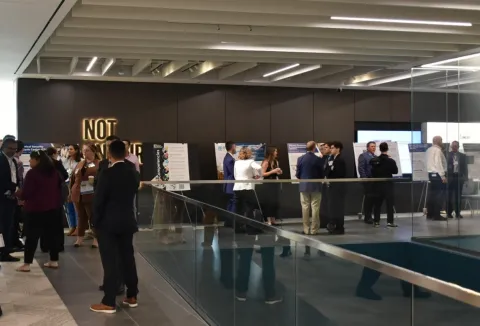Guest post from Dr. Jennifer Lutz, S&T Laboratory Utilization Manager, S&T Office of National Laboratories (ONL).

How can you communicate to colleagues and stakeholders the complexities, successes, and challenges that the Science and Technology Directorate (S&T) and the U.S. Department of Energy (DOE) face within the Homeland Security Enterprise (HSE)? One way is to follow the axiom “explain and inspire.” And that’s exactly what DHS’s Research, Development, Test and Evaluation (RDT&E) Summit is all about. This summer, S&T ONL hosted the event, a space where program managers from within S&T, and from across DHS’s operational components, could hear from leading S&T and DOE experts on future and current RDT&E capabilities, have meaningful discussions, and forge relationships to further innovation and collaboration.
Over 350 DHS and DOE attendees convened for the event held at the Transportation Security Administration headquarters in Springfield, Virginia—almost double the number from last year’s event. The summit is a critical activity to fulfill S&T’s mission as the scientific arm of DHS. It gives program staff and technical experts an opportunity to learn about cutting-edge science and engineering capabilities available to them, capabilities they can tap into to address critical homeland security challenges. Collectively, S&T and DOE provide the HSE with access to capabilities found in 22 national laboratory facilities, five here at S&T and another 17 at DOE with whom we have collaborated with for more than 20 years. In addition to organizing site visits for staff interested in engaging with this lab network, our ONL Lab Utilization Branch found a quicker way: bringing all the labs directly to them over the course of two jam-packed days.

We launched the first summit virtually in 2021 due to the pandemic. We have grown steadily since, hosting two consecutive in-person meetings. Here are a few examples of RDT&E capabilities that were showcased this year in presentations, panel discussions and at a poster session:
Addressing airports’ future energy needs. To meet the potential fivefold increase in electrical demand at airports over the next 25 years, the DOE National Renewable Energy Laboratory (NREL) is developing technical solutions so that energy loads can be dynamically analyzed, forecasted, and managed, without slowing the flow of commerce. For example, NREL will develop energy system digitalization, microgrid methodologies and related energy technologies for building and vehicle loads.
Overview of U.S. Government-Sponsored Testing of Handheld Opioid Detectors. To stem the flow of toxic and illicit synthetic opioids, law enforcement operators have a significant need to detect and presumptively identify material in the field and outside of any standard chemical laboratory. S&T’s Chemical Security Analysis Center (CSAC) conducted an assessment, summarizing the variety and performance of available detection equipment so that operators can understand and compare the technical data to guide optimization of detection procedures.
Assessing Plant Disease Detection Technology. To help intercept plant diseases and pests without slowing the flow of commerce at ports of entry, S&T and Oak Ridge National Laboratory assessed currently available and emerging plant disease detection technology. The assessment found a promising single-use immunological method for rapid detection and instruments detecting biogenic volatile organic compounds (BVOC). S&T plans to further develop a BVOC detection system for identifying non-permitted pests and plant diseases, as well as meats and agricultural products coming though the ports of entry.
It is hard to capture in one blog post the true breadth of knowledge sharing that took place at the Summit, or to demonstrate the smaller, unscripted, moments—like lunchtime and break conversations—where the true magic happened. Connections made here will likely lead to several future collaborations.
ONL Director Paul Strang agreed: “I love sitting in on prolonged conversations that start up in the break between meetings. Direct interaction really leads to free thinking.”
“The impromptu conversations here are extremely important in keeping those relationships going. The solutions we are creating today are the solutions we hope to customize to meet tomorrow’s threats,” added S&T Office of Innovation and Collaboration Director Wallicia Tapscott in her keynote speech.
For many attendees, participating is not only about identifying future opportunities but also refining the direction of current research and avoiding duplication of work. “Learning about capabilities, services and expertise we have access to helps me find prospective performers when DHS components’ needs arise,” said S&T Portfolio Manager Dr. Angela Ervin.
On the heels of a successful 2024 Summit, we are already looking ahead to next year. We will incorporate our already robust Subject Matter Exchange, a program that partners S&T scientists with their DOE counterparts to collaborate on shared research interests. All these efforts where S&T and DOE staff and researchers collaborate directly today could lead to solving the homeland security challenges of tomorrow.
Visit the S&T Office of National Laboratories to learn more about the laboratories. For related media inquiries, contact STMedia@hq.dhs.gov.
